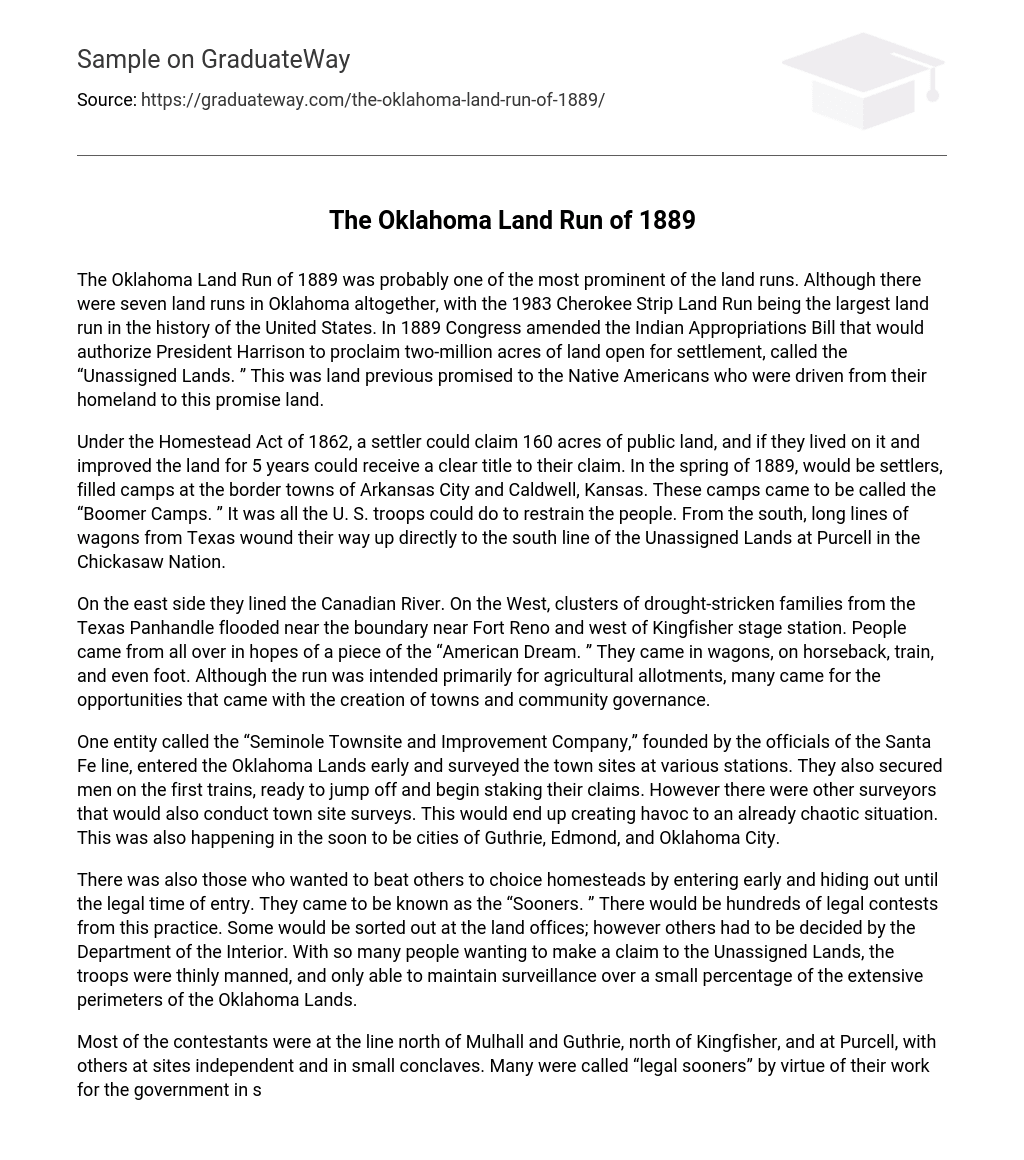The Oklahoma Land Run was probably one of the most prominent of the land runs. Although there were seven land runs in Oklahoma altogether, with the 1983 Cherokee Strip Land Run being the largest land run in the history of the United States. In 1889 Congress amended the Indian Appropriations Bill that would authorize President Harrison to proclaim two-million acres of land open for settlement, called the “Unassigned Lands. ” This was land previous promised to the Native Americans who were driven from their homeland to this promise land.
Under the Homestead Act of 1862, a settler could claim 160 acres of public land, and if they lived on it and improved the land for 5 years could receive a clear title to their claim. In the spring of 1889, would be settlers, filled camps at the border towns of Arkansas City and Caldwell, Kansas. These camps came to be called the “Boomer Camps. ” It was all the U. S. troops could do to restrain the people. From the south, long lines of wagons from Texas wound their way up directly to the south line of the Unassigned Lands at Purcell in the Chickasaw Nation.
On the east side they lined the Canadian River. On the West, clusters of drought-stricken families from the Texas Panhandle flooded near the boundary near Fort Reno and west of Kingfisher stage station. People came from all over in hopes of a piece of the “American Dream. ” They came in wagons, on horseback, train, and even foot. Although the run was intended primarily for agricultural allotments, many came for the opportunities that came with the creation of towns and community governance.
One entity called the “Seminole Townsite and Improvement Company,” founded by the officials of the Santa Fe line, entered the Oklahoma Lands early and surveyed the town sites at various stations. They also secured men on the first trains, ready to jump off and begin staking their claims. However there were other surveyors that would also conduct town site surveys. This would end up creating havoc to an already chaotic situation. This was also happening in the soon to be cities of Guthrie, Edmond, and Oklahoma City.
There was also those who wanted to beat others to choice homesteads by entering early and hiding out until the legal time of entry. They came to be known as the “Sooners. ” There would be hundreds of legal contests from this practice. Some would be sorted out at the land offices; however others had to be decided by the Department of the Interior. With so many people wanting to make a claim to the Unassigned Lands, the troops were thinly manned, and only able to maintain surveillance over a small percentage of the extensive perimeters of the Oklahoma Lands.
Most of the contestants were at the line north of Mulhall and Guthrie, north of Kingfisher, and at Purcell, with others at sites independent and in small conclaves. Many were called “legal sooners” by virtue of their work for the government in some capacity. Those where railroad men, carpenters, teamsters, woodcutters, soldiers and federal officials. The most notorious to take advantage of their authority were the U. S. marshals and their deputies. They went ahead of the run and staked their claim. Most staked claim to would be city lots or future commercial lots.
The greatest moment came when at the stroke of noon on April 22, 1898; the signals to start were given at the many points of entry. In some instances it was a military officer firing his pistol or the sound of a trumpeter, a citizen firing his rifle, or even at Fort Reno the boom of cannon. They all produced the same result, a tumultuous avalanche of wagons, horses and men surging forward at on instant. On April 22, 1989 there was utter confusion, chaos, and excitement with the sound of men and women rushing to set claim to their new homesteads, or to town lots that sprang up overnight.
It is estimated that 10,000 settlers sprang up in Guthrie along, and over eleven thousand agricultural homesteads were claimed. Many hardships were ahead. Many would be contesting others claims to the same farm or lot. A few of the “sooners” cases ended up in the U. S. Supreme Court. However April 22, 1989 is a significant day in our history. It was one that gave new found hope to thousands of American’s and an iconic image in the history of the West. It also set the stage for the creation of the forty-sixth state of the Union, Oklahoma, in 1907.
Works Citied
- http://digital.library.okstate.edu/encyclopedia/entries/L/LA014.html
- http://en.wikipedia.org/wiki/Land_run
- http://www.library.cornell.edu/Reps/DOCS/landrush.htm





